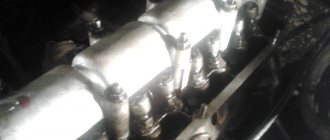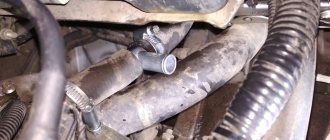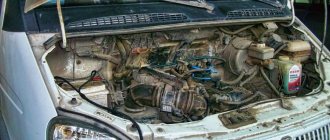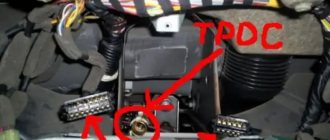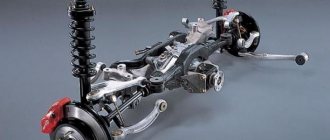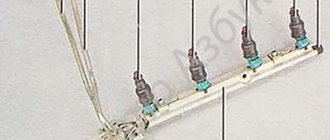Optimal engine speed.
Every driver should know what speed is optimal for the engine of his car, this knowledge will not only help save some money on fuel and repairs, but possibly also save a life, because without knowing the capabilities of your car, without knowing how to use its engine, you can put yourself in danger and its passengers.
Let's start with the fact that there are no universal speeds for all operating modes
. To warm up the engine, certain revolutions are required, for overtaking others, and for measured movement around the city, others.
Let's start with, of course, starting the engine, immediately after turning the key, the engine starts running at higher speeds (compared to idling). In this situation, this is the optimal speed for warming up the engine.
(usually 1100-1200 rpm), to supply frozen oil and thermal expansion of the connecting rod and piston group to the working size (you can read more here). If you want to extend the service life of your engine, you should not try to get rid of them, reflash the ECU, apply gas to warm up faster, but it is not recommended to start driving at warm-up speeds.
When the ShPG reaches operating temperature, the engine goes to idle speed
(600-800 rpm)
- this is the optimal speed for a stationary car
. The engine runs in light mode, just to avoid stalling and ensure minimal fuel consumption. The shafts rotate almost in a free state, they are not loaded and there is practically no wear in them, if not for one BUT: the oil pump also operates at minimum modes, if the oil is fresh and of high quality, then there will be no problems, the pump will drive it through all channels and throw it into the most inaccessible places, thereby lubricating them and cooling them. If the oil does not have the required qualities, the oil pump cannot cope, the engine begins to overheat little by little, deteriorating the oil even more and little by little oil starvation occurs and, as a result, increased engine wear.
So, we put the car in gear and started driving. Optimal speed for uniform straight-line movement on a flat surface
usually in the range from 1800 to 2000 rpm. In this mode of operation, the engine produces exactly as much as is necessary to maintain movement at a given speed with minimal fuel consumption. Usually the engine and gearbox are selected so that at these speeds the maximum permitted speed on the road is ensured. For example, 60 km/h in fourth speed at 2000 rpm or 90 km/h in fifth speed at 2000 rpm. Perhaps this is the ideal operating mode of the engine in terms of durability and fuel consumption, the engine is practically not loaded, the oil is evenly distributed and lubricates everything, but there is one caveat - an engine that has been running for a long time at such speeds can fail at the most inopportune moment.
Situations on the road are different, sometimes you just need to accelerate at a traffic light in order to change lanes in time, and sometimes you need to quickly overtake a truck, in this case, the optimal speed for fast acceleration will be the speed that creates maximum torque
. At these revolutions, the car is given the greatest acceleration, and the engine experiences enormous loads, and it is at this moment that the engine, which has run in at 2000 revolutions, can fail. When the engine is running, the engine connecting rods, under the influence of the inertia of the piston, are slightly extended; the higher the speed, the stronger the deformation (the connecting rod is longer). During long-term operation in gentle modes, a groove forms on the cylinder walls; it is only a few hundredths of a millimeter deep, but this is quite enough so that when switching to high speeds, the wear of the piston rings increases, and there is a possibility of damage and destruction of the rings.
Consolidation of received information about participatory turnover
In the Russian language textbook for grade 7 by M. M. Razumovskaya, assignments on p. 75-78. Let's list some of them.
● Replace the highlighted words with appropriate participial phrases and complete the sentences. Indicate in each of them the word being defined and the participial phrase. In participles, highlight suffixes and endings.
Review the sentences you wrote down. Prove that the following scheme is suitable for each of them:
Rearrange your sentences to fit the following diagram:
Determine whether the punctuation of the sentences will change. Write down two rearranged sentences (of your choice), indicating the words being defined and participial phrases in them.
We offer one of the options for performing the exercise.
| Original proposal | Sentence edited by a student | A sentence edited by a student according to the diagram |
| A boat being carried away by a strong current... | The boat, carried away by a strong current, quickly rushed downstream. | Carried away by a strong current, the boat quickly rushed downstream. |
| The book that the schoolboy read... | A book read by a schoolboy lay lonely on a bookshelf. | The book the schoolchild had read lay lonely on the bookshelf. |
| Clouds driven by the wind... | The clouds, driven by the wind, brought with them a storm. | The wind-driven clouds brought with them a storm. |
| Old letters that grandma keeps... | The old letters kept by the grandmother have turned yellow with age. | The old letters kept by my grandmother have turned yellow with age. |
| The earth that is illuminated by the sun... | The earth, illuminated by the sun, quickly warmed up. | The sunlit earth quickly warmed up. |
Seventh graders can share their observations that the participial phrase explains the word being defined, answers the question of definition and is underlined by a wavy line; draw a conclusion about the change in punctuation when restructuring sentences: if the participial phrase comes before the word being defined, it is not isolated.
● Read the examples clearly and determine why they are divided into two groups. Determine which group of examples each of the schemes corresponds to.
Draw diagrams and for each of them write out the corresponding participial phrases with the words they define from the sentences.
Perform a morphological analysis of the selected words.
Seventh graders can draw two diagrams and give examples from each group of sentences; conclude that the sentences are divided into two groups based on the fact that the participial phrase in relation to the word being defined can occupy different positions, and remember the rules for isolating the participial phrase.
In the textbook on the Russian language for grade 7 by S. N. Pimenova, A. P. Eremeeva, A. Yu. Kupalova and others (UMK V. V. Babaytseva) on p. 35-44 provide such exercises to consolidate knowledge about the participial phrase and the rules for its isolation.
● Copy the sentences, matching the participles given in brackets with the highlighted defined words (ask questions about the definitions from them so as not to make a mistake in choosing the endings!). Indicate the participial phrases graphically.
Students can complete the exercise this way:
| Original proposal | Sentence edited by a student |
| An angle is a geometric figure (formed by) a point and two rays (emanating) from this point. | An angle is a geometric figure formed by a point and two rays (emanating) from this point. |
| The idea of a straight line is given by a (stretched) ray of light (emerging) from a small hole. | The idea of a straight line is given by a stretched ray of light emerging from a small hole. |
| Points (belonging to) a line are said to lie on the line. | Points belonging to a line are said to lie on the line. |
| A triangle is a figure (consisting) of three segments, pairwise (connecting) three points, (not lying) on the same straight line. | A triangle is a figure consisting of three segments connecting in pairs three points that do not lie on the same line. |
Schoolchildren will make an important conclusion that the participle explains the word being defined and agrees with it in number, case and gender (singular), answer the questions of defining which? which? which? etc. Consequently, whether the student can find the word being defined and ask the correct question from it depends on whether he will make a mistake when using the participial phrase or not.
● Explain errors in the use of participles and correct them. Write down the edited sentences, emphasizing the participial phrases.
Here is a version of this exercise:
| Original proposal | Sentence edited by a student |
| Along the edges of the road one could see stunted poplars with leaves turning gray from dust. | Along the edges of the road one could see stunted poplars with leaves (what kind?) turned gray with dust. |
| He did not notice any forests or lakes overgrown with water lilies. | He did not notice any forests or lakes (which ones?) overgrown with water lilies. |
| People use water from a well flowing from the bowels of the earth. | People use water (what kind?) from a well flowing from the bowels of the earth. |
| The first leaves bloomed on the trees growing near the house. | The first leaves (which ones?) bloomed on the trees, growing near the house. |
| We approached a house that stood in a small clearing and was illuminated by the bright rays of the sun. | We approached a house (which one?), which stood in a small clearing and (which one?) was illuminated by the bright rays of the sun. |
The exercise is aimed at developing in schoolchildren the ability to choose the correct form of participle-attribute and use it correctly.
We believe that among the main results at this stage of training, indicating that schoolchildren have successfully mastered information about the participle phrase, it is necessary to mention the ability to graphically highlight the participial phrase with a wavy line, find the word being defined and ask a definition question from it to the participle ( which? which? which?
and etc.).
Russian language. In-depth study. 7th grade. Workbook
The manual for the educational and methodological complex of V.V. Babaytseva (in-depth study) is intended to test the assimilation of the material studied by seventh-graders and the formation (improvement) of their subject and general subject (meta-subject) skills. In addition, the manual can be used for self-education, to fill gaps in knowledge, to update students’ previously developed skills, as well as to prepare for the state final certification in the Russian language.
Buy
Vehicle speed, engine speed and engine load: what you need to know
Let's start with the fact that many drivers are often faced with the fact that fuel consumption during the operation of a car differs markedly from the data declared by the manufacturer itself. More precisely, the engine is fully operational, but in terms of fuel, the “appetite” of this or that internal combustion engine is noticeably greater than according to the passport.
Let us add that there is a lot of controversy around various techniques and methods that help save fuel when driving. Some drivers believe that whenever possible they need to coast in neutral gear, others always try to engage a higher gear as early as possible and regardless of the speed of the car, others monitor the speed, not allowing the needle on the tachometer to rise above a certain threshold and etc.
Next, we will talk about the relationship between engine speed and speed, at what speed and in what gear you can drive with maximum fuel efficiency, and also what modes can be considered the most gentle for the engine itself.
Consolidation of received information about adverbs
The Russian language textbook for the 7th grade of UMK M. M. Razumovskaya includes five tasks to consolidate schoolchildren’s knowledge about participial phrases, among which we will highlight the following exercises.
● Copy, emphasizing the grammatical basis of sentences and circumstances. How are these circumstances expressed?
Using these examples, schoolchildren will talk about punctuation marks in participial phrases and identify the sentence (third) that contains the participial phrase, graphically designate it and draw a conclusion about the main difference between participial and participial phrases.
● Copy by inserting missing letters and punctuation marks. Emphasize the grammatical basis of the sentences. Indicate the adverbial phrases.
We offer an option for completing this task:
When performing this exercise, seventh-graders will definitely see the use of the participial phrase in the text (in sentences 1 and 2), indicate it graphically and name the questions that the participial phrase answers ( which? which? which?
etc.) and participle phrases (
how? how?,
etc.).
In the textbook on the Russian language for the 7th grade of UMK by V.V. Babaytseva (p. 92-98), we would like to highlight several exercises, the implementation of which, in our opinion, will develop in schoolchildren the ability to use participial phrases.
● Choose dependent words that suit the meaning of the participles. (Watch the word order!) Write down the sentences, emphasizing the adverbial phrases and explaining the placement of commas.
● Here are sentences with punctuation errors. Explain the reason for their occurrence. Write down the sentences in corrected form.
By correcting punctuation errors in these sentences, seventh-graders will learn to see the “boundaries” of adverbial verbs and draw a conclusion about the importance of analyzing sentences of this nature.
Russian language. 7th grade. Tests
The authors note that the manual is intended to organize systematic control of the student. In particular, for self-control. The collection presents a system of training test tasks for all sections of the 7th grade curriculum. The accessible format of the publication allows for test control at school and at home. A collection of test tasks in the Russian language from the UMK line M.M. Razumovskaya consists of two parts - linguistic and speech.
Buy
Speed and revolutions: fuel savings and engine life
So, you can often hear from drivers that as soon as the car accelerates to 60 km/h, you can engage, for example, 5th gear (if the gearbox is 5-speed). In this case, the speed will drop to 1900-2000 thousand rpm and in this mode fuel consumption will be minimal. In other words, the most economical option is to drive when the highest gear is engaged and the speed is low.
If you study the theoretical part a little, accelerating to a certain speed will require energy expenditure. The more intense the acceleration occurs, the more energy is consumed. After reaching a constant speed (cruising), fuel consumption becomes less, but it must be taken into account that the car also overcomes air resistance.
It turns out that to maintain a speed of about 50 km/h, you need about 30-35 hp, while when accelerating to 120-130 km/h, 80-90 “horses” are needed to overcome resistance to air flows. To this you need to add the mass of the car itself, which is different for each vehicle, make allowances for road conditions, etc.
VAZ 2114 engine repair
AvtoVAZ claims the engine's service life is 150 thousand kilometers, after which it will require major repairs. But with proper maintenance and regular oil changes, every 8-12 thousand km, the VAZ 2114 engine can travel up to 250 thousand km without major problems.
Rebuilding an internal combustion engine requires a careful inspection of all components and assemblies. Mechanical damage indicates the need to replace the part. In addition, all gaskets and washers must be changed.
Different models of VAZ 2114 engines have their own design flaws.
How to achieve fuel efficiency without harming the engine
First of all, you need to determine at what speed in each gear the engine speed on a particular vehicle drops below 1800-2000 rpm. As a rule, for most engines, 1.8-2 thousand revolutions are the “minimum” when the pressure in the lubrication system is already sufficient to avoid increased wear.
Secondly, you must take into account road conditions. For example, a car moves at a speed of 60 km/h in 5th gear on a flat road, but then it begins to rise. The driver can either press the gas harder to maintain the speed, or shift to a lower gear.
So, in the first case, the load on the engine will be very large, and there is also a risk of detonation. At the same time, there is no longer any fuel economy, since you have to press the gas harder to maintain the selected speed. It turns out that the gasoline in the cylinders burns more intensely, and there is no traction in high gear, while the car overcomes the climb with great difficulty.
If you study the basic recommendations of experts regarding what revolutions, speed, gears and other factors affect fuel consumption and the life of the internal combustion engine, then for gasoline engines the following can be distinguished:
- It is extremely undesirable to constantly drive at speeds below 2000 thousand;
- it is necessary to select the gear in accordance with the road conditions;
- movement in the highest gear should occur at optimal speed;
It should also be noted that to save fuel it is very important to learn how to maintain inertia. In practice, this means that you should not use the brake unless necessary, be able to use engine braking, change gears in a timely manner, taking turns with minimal loss of previously gained speed, etc.
Please note that such driving requires an understanding of all the processes taking place, that is, an inexperienced driver first needs some professional training (contingency driving), only after which can the acquired knowledge be applied in practice!
Methodical comment
As our analysis of textbooks on the Russian language for the 7th grade of the mentioned educational and methodological sets showed, the “repertoire” of exercises that form the ability to see participial phrases and participial phrases in a sentence, correct violations when using them, and use them in one’s own speech is quite wide.
In our opinion, when studying the peculiarities of participial and adverbial phrases based on the teaching materials of V. V. Babaytseva and the teaching materials of M. M. Razumovskaya, the teacher needs to draw a parallel between the participial phrase and the definition, the participial phrase and the adverbial phrase, to consolidate the knowledge of schoolchildren by performing an exercise (for example, presented above).
We believe that such differentiation of educational material will allow schoolchildren to avoid confusion between participial and participial phrases and, as a consequence, mistakes. #ADVERTISING_INSERT#
Let's sum it up
As you can see, a smooth ride without sudden acceleration and braking, coasting, selecting and maintaining the optimal speed due to inertia, as well as a number of other techniques allows you to achieve significant fuel savings without harm to the engine. It is important to be able to choose the right gear for a given speed, while maintaining the speed in the desired range.
Finally, we note that the optimal driving speed for maximum fuel efficiency in high gear will differ from vehicle to vehicle. It all depends on the engine size, vehicle weight, etc. Also, we should not forget that fuel consumption is greatly influenced by the condition of the spark plugs, oil and fuel filters, the efficiency of the cooling system, etc.
Engine speed and service life. Disadvantages of driving at low and high speeds. At what engine speed is it best to drive? Tips and tricks.
Why doesn't a diesel engine need to be cranked like a gasoline engine? Features and differences of diesel internal combustion engines in comparison with gasoline ones. Optimal speed.
For what reasons does piston pin knocking occur during vehicle acceleration and operation under load: fuel quality, ignition, mixture composition, and others.
Why does the fuel-air mixture detonate in the combustion chamber? Reasons causing detonation. Consequences of detonation combustion of fuel in internal combustion engine cylinders.
How to determine engine detonation yourself: the main signs and sound of engine detonation. The reasons for the occurrence, as well as what the driver should do in this case.
The appearance of knocking noises in different diesel operating modes. Fault diagnosis. The nature of the knocks of the crank mechanism, timing gear, and fuel equipment.
Source
Theoretical foundations for the study of participial phrases
In the educational and methodological kits under consideration, theoretical information about participial phrases and the rules for its isolation is presented in a similar way:
● the participle phrase is defined in textbooks on the Russian language for 7th grade as a gerund with words dependent on it (for example, sliding on the morning snow
);
● like single participles, the participle phrase is considered in a sentence as a circumstance (i.e., it answers the question of circumstance how? in what way?
and etc.);
● the rules for isolating the participial phrase are formulated as follows: it is always highlighted in writing with commas, for example,
Other reasons
In extremely rare cases, even after repairing and replacing all the sensors listed above, high idle speeds may still remain.
The reason here may lie either in defective devices installed instead of failed ones (unfortunately, this sometimes happens with domestically produced parts) or in the installation of sensors of a model different from the original one.
In the latter case, you should pay attention to the idle speed sensor, since they are produced in two variations - an earlier and a later one (which is installed on 2114).
If, instead, a sensor from an early series was installed, which has an adjusting screw, then it should be fine-tuned by carefully turning the head of the screw and at the same time observing the state of the revolutions.
